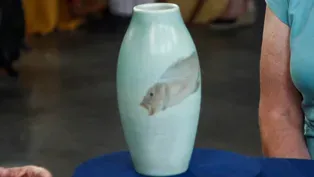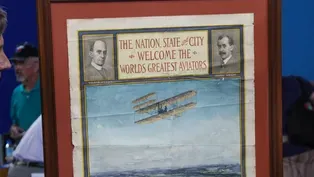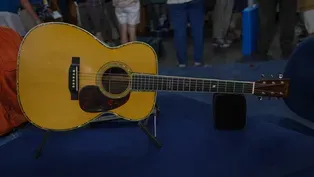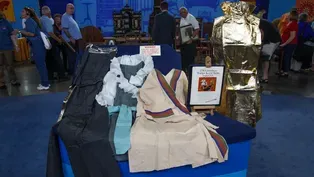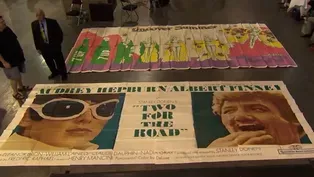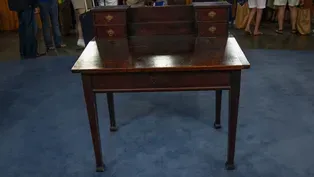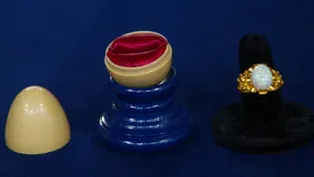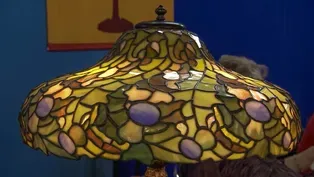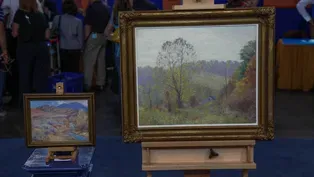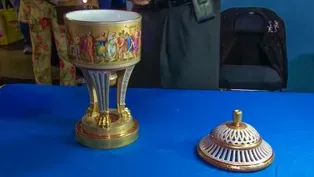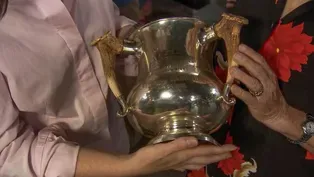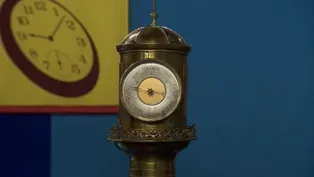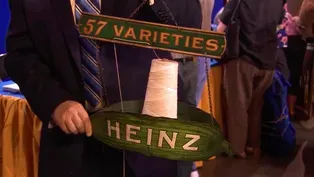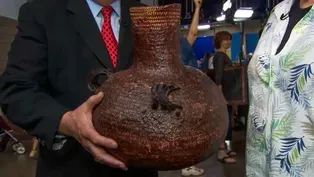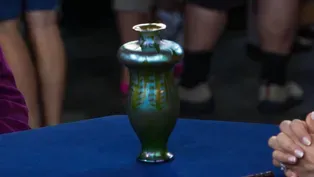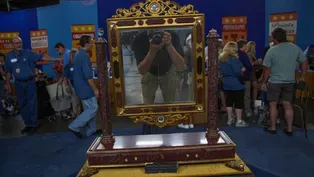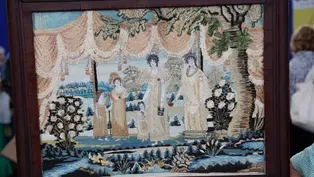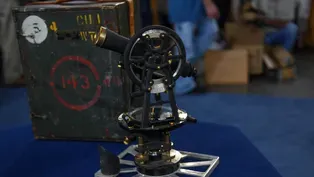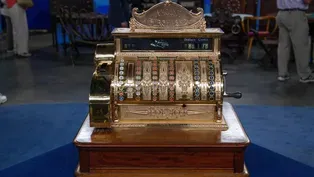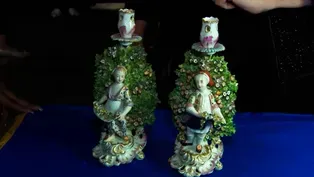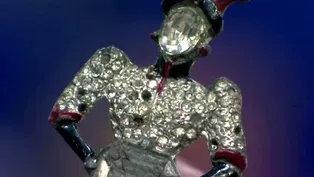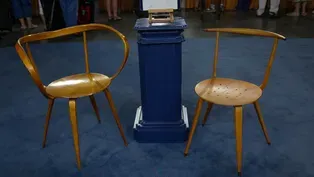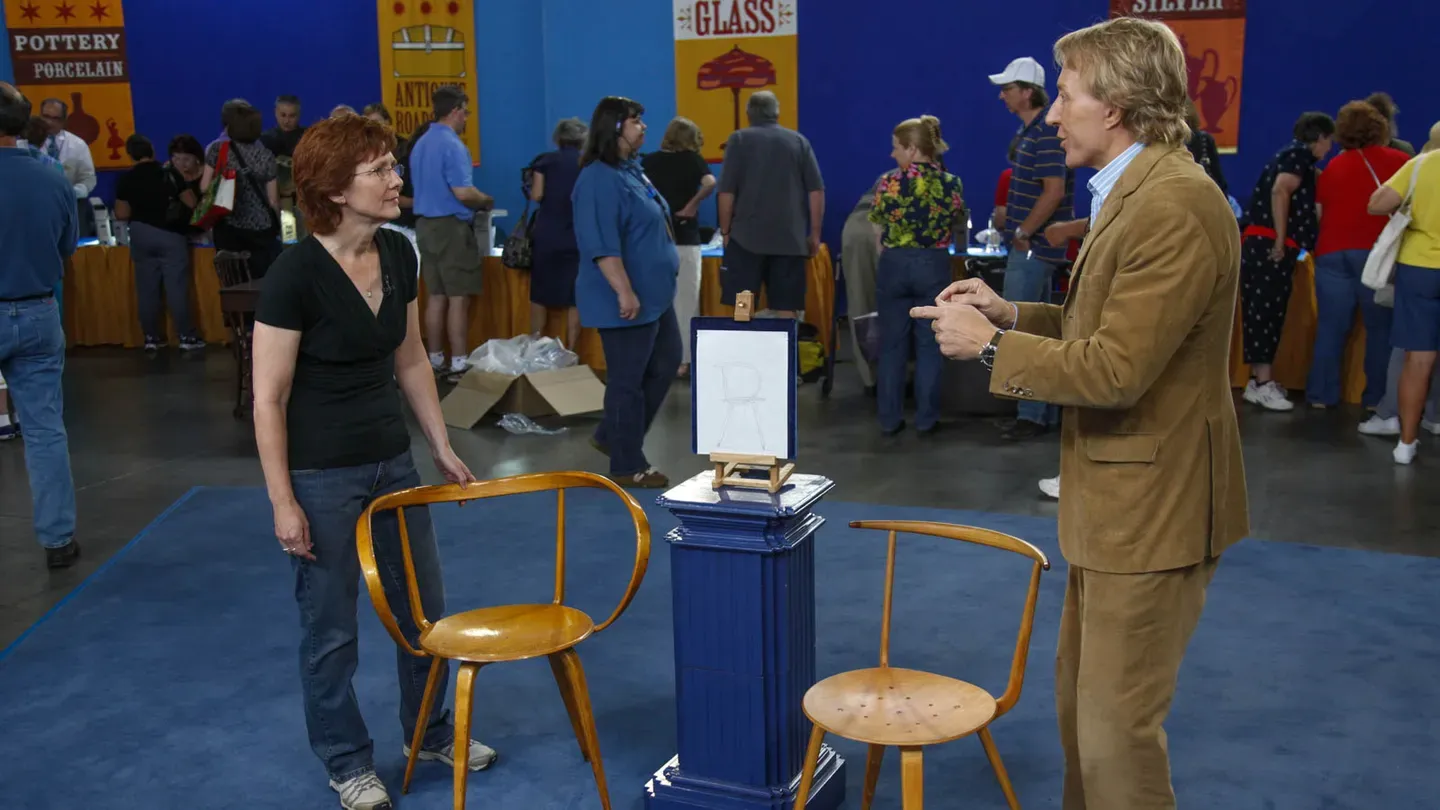

Vintage Denver 2024, Hour 1
Season 28 Episode 18 | 52m 25sVideo has Closed Captions
Discover updated Denver delights from ROADSHOW's 2009 visit! One is now up to $150,000!
Discover updated Denver delights including a 1941 C. F. Martin 000-42 guitar, a Louis XVI-style porphyry & bronze mirror, ca. 1880, and a Maria Koogle schoolgirl needlework, ca. 1817. One almost tripled in value to $115,000 to $150,000!
Problems with Closed Captions? Closed Captioning Feedback
Problems with Closed Captions? Closed Captioning Feedback
Funding for ANTIQUES ROADSHOW is provided by Ancestry and American Cruise Lines. Additional funding is provided by public television viewers.

Vintage Denver 2024, Hour 1
Season 28 Episode 18 | 52m 25sVideo has Closed Captions
Discover updated Denver delights including a 1941 C. F. Martin 000-42 guitar, a Louis XVI-style porphyry & bronze mirror, ca. 1880, and a Maria Koogle schoolgirl needlework, ca. 1817. One almost tripled in value to $115,000 to $150,000!
Problems with Closed Captions? Closed Captioning Feedback
How to Watch Antiques Roadshow
Antiques Roadshow is available to stream on pbs.org and the free PBS App, available on iPhone, Apple TV, Android TV, Android smartphones, Amazon Fire TV, Amazon Fire Tablet, Roku, Samsung Smart TV, and Vizio.
Buy Now

ANTIQUES ROADSHOW 2025 Tour!
Enter now for a chance to win free tickets to ANTIQUES ROADSHOW's 2025 Tour! Plus, see which cities we're headed to!Providing Support for PBS.org
Learn Moreabout PBS online sponsorship♪ ♪ GUEST: It was actually done by my great-great grandmother.
That one, I think, was a little closer to ten dollars, but-- Ten dollars.
My grandfather made fun of them, 'cause every fool knew that you would die trying to fly.
♪ ♪ CORAL PEÑA: When "Roadshow" visited Colorado in 2009, the Great Recession was just winding down, a period of economic downturn which impacted the values of everything, from family homes to family heirlooms.
APPRAISER: Now, the question I have is, how many times are we gonna multiply this times $455 to get to today's values?
I have no idea.
(both laugh) PEÑA: The treasures we found that day weathered the financial storm, but how have they done in the 15 years since?
Let's find out which values have gone up, down, or stayed the same in "Antiques Roadshow: Vintage Denver."
GUEST: My great-uncle used to play live on the radio.
"Cowboy Slim" is what he went by.
And in 1952 a buddy of his wanted to sell him this guitar.
Initially he didn't have the money, he didn't want to buy it.
Um, his friend told him pay him when got the money, so he paid him the $50 when he got the money.
And he passed away in December of 1989, and then I got it.
Have you had the guitar appraised, have you had it evaluated?
Yeah, years ago, in the early '90s.
Um, they appraised it from pictures that I sent off, and they said around $10,000.
And they were interested in buying it if I wanted to sell it, which... (chuckles) seemed unusual.
You didn't sell it.
No.
Well, that's probably a good thing.
This is a C.F.
Martin guitar.
C.F.
Martin guitars started in New York City in 1833.
By the time this guitar was made, they had moved to Nazareth, Pennsylvania, where they are today.
It's a 42 style.
42 means that it has the pearl around the body.
It doesn't have the pearl around the back and sides.
It's also called the 000.
That's the body size.
This guitar was made in 1941.
1942 was... was the World War.
They quit making fancy things for a while.
So 1942 was the last year that they made this model.
Okay.
They did make a fancier model.
They made a 000-45.
But, for some reason, the 000-42 has become the rarest and hardest to find Ah.
of the pearl guitars.
It was kind of the poor man's pearl guitar.
It was an inexpensive guitar from day one, but it only had the pearl on the front.
From the back we can see that it's Brazilian rosewood, has standard ivoroid trim, but no pearl.
The tuners that they used back in the '30s, which was kind of the golden era of Martin guitars, weren't available during the war, so they used a lower grade tuner.
The fact that it has these lower grade tuners and somebody didn't go back later and put more expensive tuners on it is really a good thing, because that preserves the originality of the guitar.
I'm going to go back to the front of the guitar.
It has an ebony bridge and ebony fretboard that's bound in ivoroid.
This is the nicest example of this guitar I have seen.
This guitar was made popular about ten years ago, uh, by Eric Clapton on the "Unplugged" album.
Mm-hmm.
He was playing a 000-42.
This is an extraordinarily nice, clean example.
I would put the value of this guitar, in a retail environment, between $65,000 and $75,000.
That's pretty good.
That sound good to you?
Yeah, not for sale, but it sounds good.
Well, good, good.
It's in excellent playing condition, so there's no reason not to play it.
No.
(chuckles) Yeah.
In this environment, a lot of things have gone down in value.
It's always-- it's going to hold its value in any environment.
GUEST: I brought two chairs that were designed by my father, John Pyle, when he worked for George Nelson in the 1950s in the design studios in New York City.
He designed these, um, chairs, he designed also the, um, steel frame furniture line...
Okay.
...and other types of furniture for George Nelson.
A lot of people don't-don't know that George Nelson was an architect and that he had people working for him like your dad.
Yes.
And what happened was the George Nelson name went with the furniture...
Right.
...but the designers themselves rarely got individual credit.
Well, what you have there, and I know you know the name of it, because you've grown up with this chair, right?
Yup, yup, these were always in our house growing up.
Always in your house.
The chair you're next to is called a pretzel chair.
And that name only started in the 1980s.
Right.
In 1952, when your dad designed both of these chairs, it was called a laminated chair.
And it took 30-some years to call it the pretzel chair.
Now, the crest rail is bent, and it comes around, and the legs are bent at the top.
Right.
It's made of natural birchwood.
And very few of these were made.
1952 he designed it, but they didn't come out until, what?
About 1957, I believe.
'57, and they were sold in '58, I think...
Right, right.
...at-at least, so, they made very few of 'em because it was difficult to bend that wood, right?
Yes, yes, that was the big challenge, was how to mass-produce this curve.
And do it inexpensively, right?
Right.
I think at first the company suggested selling them for $100.
Yes.
And in 1958, who would sell a chair for $100, right?
One chair for $100.
So they dropped down the price, made them affordable, but still there were only about 100 of those made.
So they're-they're quite rare.
Yup.
Now, tell me about the drawing.
That was done by your father, John Pyle, right?
Yes, yes, this is one of the sketches of the design of the pretzel chair.
It's a profile view of the pretzel chair.
Of this chair.
That's invaluable to have that drawing that... Mm-hmm.
...of-of... from your dad.
Now, this chair, the-the cool thing about this, and I was so excited to see it, is that it is a prototype.
This is a sample chair your dad made.
Yep.
When I saw these screws in the top, I knew that this chair your dad made as not to be sold as production.
Right.
And it's not finished, it's not varnished.
Right.
So I was very excited to see it.
It's-it's made of birch, and the tips on the crest are walnut.
If we tip it forward, we can see the holes.
And you know why those holes are there.
What was it?
I think to attach the cushions.
To-to-to...
There are cushions that go with these chairs.
To tie down the cushions.
Right.
They must have been attached to strings, right?
Yeah.
There are certain people in the field that only collect prototypes.
The pretzel chair-- the laminated chair... Uh-huh.
...using period terminology would be worth about $2,000 to $3,000 at auction.
Mm-hmm.
Right.
And it might bring $4,000, because they never come up.
This chair, the prototype.
Uh-huh.
Could bring $10,000 to $15,000 at auction.
For this side chair.
Oh, wow, okay.
GUEST: It was in my husband's family, and it got handed down.
APPRAISER: This is made by an American company out of New York called Duffner & Kimberly.
Duffner & Kimberly was a rival to Tiffany Studios.
In fact, one of the partners, Oliver Kimberly, used to work for Tiffany... Uh-huh.
...in the late 1890s.
This, in a soft economy, is easily $15,000 to $18,000.
Wow, that's great.
Thank you.
Well, talk about flashy, this is one flashy piece of porcelain.
It's from my grandfather; we were totally clueless as what it was, what it was for; is it for incense?
Is it an urn or...?
The top being pierced like this is a very good hint of what it was used for, which would've been a potpourri.
Beautifully hand-painted and enamel decorated as we surround the piece; the gilding is immaculate.
Very, very clean example.
And in a well-advertised auction, I would expect it to sell in the range of $3,000 to $5,000.
Wow.
Really?
It's as clean as can be, and really, a nice example.
APPRAISER: You brought in a box of your mother's jewelry that she collected over the years.
And how many pieces do you think was in that box?
I'd say 100, maybe.
About 100 pieces.
And at the very bottom of it, I found this little guy.
This is called a trembler, or the French term is "en tremblant."
In the 1700s, they did "en tremblant" pins that were flowers that were worth thousands of dollars.
This is from the late '30s and 1940s.
It's pot metal, rhinestones, has two precious little Scottie dogs, a very stylish lady with rhinestone embellishments.
What do you think she might be worth?
A good bottle of wine?
(laughing) That's a, that's a great idea.
No, she's worth about $300 to $400.
Oh, my.
Well, that is surprising.
Yes.
GUEST: I bought this at a garage sale about five years ago.
I bought it from a guy in the military, and he told me that it was a World War II Marine Corps transit that they used to sight artillery with.
Well, we know first of all that it is Marine Corps, because it clearly shows "USMC" in the center.
Right.
United States Marine Corps.
The Marine Corps in general were very picky about the equipment that they used.
And they had a lot of material custom-made for them instead of using material that was from the Army or the Navy, and they had a lot of independent contracts that produced their own binoculars, instruments, even weapons.
This is technically what's called a transit theodolite.
A transit theodolite is one of the more important surveying instruments, because it measures not only horizontal angles, but can measure elevation at the same time.
It most likely helped them understand the terrain there.
Certainly, it could have helped the artillery folks understand the elevations and where to direct it.
The transit here is made out of brass, so that it wouldn't affect the mag-- the compass that's inside.
And then it was blackened so that it wouldn't give off any reflections.
And they used this wrinkle paint in order to dull the finish.
What's also interesting is this-this case.
Now, the Marines obviously were in the field, and they didn't want to have everybody know who they were and where they were.
Uh-huh.
So they had a code for each individual division.
This stenciled circle tells us that it was the Sixth Marine Division.
Hm.
And then the numbers inside tell us about the regiment, the battalion and the company that was involved.
So we know for sure it was the Sixth Marine Division, and they were in the Pacific for quite a while.
They were involved in Okinawa and a lot of other campaigns.
Hm.
So you have a crossover collectible here, really something that would appeal to folks with instruments as well as people in the military.
The Marines in general are considered today, and then, an elite unit.
So anything Marine Corps related is pretty scarce.
Right.
And a lot of things they brought to the Pacific didn't come home.
In all, it's a great package.
So you bought it a few years ago.
What did you pay back then?
$125.
I also got the-the tripod that comes with it.
You got a tripod, too.
Uh-huh.
That's even better.
In today's market, even with the uneven economy, Marine Corps items remain popular and the interest remains constant.
I would suggest that the transit with the division marked box, we're looking at, at auction, $800 to $1,200.
A little bit more including the-the tripod.
Wow.
It's a fantastic piece, and you'd get a lot of folks that would be really interested in it.
Yeah, that's really cool.
GUEST: I got it from my mom.
This was something that I'd always admired and wanted.
And so I've asked her about the history.
And she and my dad had received it from family friends in either the 1940s or the 1950s.
She knew that it was a Rookwood vase, but beyond that she didn't really know anything.
Rookwood pottery is one of the most important manufacturers of art pottery in America.
They were in Cincinnati, Ohio, started in the 1880s, and they did some really interesting and innovative things over the years.
They did lots of things that were artist pieces, like this, that were one-of-a-kind pieces that were hand-painted by an individual artist.
Oh.
They also later on did things that were more mass-produced.
We called it production pieces.
What's so great about this is these terrific fish that are on it.
Mm-hmm.
Yeah.
And the interesting effect of the fish, they're painted against a sea green background, as if they were underwater.
Yes.
The glazes and the colors are streaked in such a way as if they're swimming underwater.
Mm-hmm.
Now let's look at the marks on the bottom.
And we have some very typical Rookwood marks.
The first one is the standard Rookwood mark.
There's the initials "RP," with one being backwards, one being forward, which stands for "Rookwood Pottery."
Oh, okay.
There are flames around the mark, which takes us as far as dating up to 1900.
Oh.
And then underneath is the letter "V," for 1905.
So this piece was made in 1905.
Wow.
And then a factory number.
The next important mark is the V there, which is another V, which means something completely different.
That means "vellum," which is the type of glaze that this particular piece has.
Mm-hmm.
And the final important mark is the mark of the artist or the decorator.
And his name was Albert Valentine.
Oh.
Now, at certain points in his career, he signed his name "Valentine," spelled t-i-n-e, but later on he signed his name t-i-e-n, "Valentien."
There were a great many vellum glaze vases made, and this one's a particularly large one.
And the-the fish, because they're rare, and because of the charming subject matter, bring a lot more money.
This piece at auction would probably sell for at least $5,000 to $7,500 and possibly even more.
Oh, wow.
That is wonderful.
I would highly recommend that you clean this baby up.
It's dirty.
(chuckling): Give it a bath.
Yeah.
Absolutely.
GUEST: It's the last remaining lithograph from the Walker Lithography Company.
My great-grandpa, Harry Walker, started the company, and I heard lots of stories growing up from my grandpa, who lived with us.
It's of immense value to us, because it is the only remaining thing...
The Walker Lithography Company went bankrupt in the Great Depression.
Well, this is all we have.
The Wright brothers, they had a bike shop in Dayton, Ohio, so they really did the development of flight in this field you see here in the poster.
Uh, it's called Wright Field.
And my grandfather actually went down as a cool young man around town and made fun of him, 'cause every fool knew that you would die trying to fly.
So Great-Grandpa Walker actually hosted a parade when they came back from Kitty Hawk, so this lithograph was made by his company to celebrate their successful early flights at Kitty Hawk.
I did a little research on the poster, and the Wright brothers' successful flight at Kitty Hawk, the first powered flight, was 1903.
And after 1903, the Wright brothers went on tour.
They took their project to Europe.
They tried to sell the idea of airplanes to European governments.
They tried to sell it to the military.
So what this poster is advertising is their great homecoming returning from Europe in 1909.
Ah.
Okay.
And the celebration in Dayton was huge.
These were hometown heroes, and it was a two-day, mammoth celebration of all things Wright.
To the best of my research, though, it's curious, I don't think there was actually a flying exhibition on that day.
So this poster is really a romantic vision, and the fact that the poster so accurately and beautifully re-creates a Wright flyer makes it of a lot of interest to people who study the history of aviation.
Now, in 1909, aviation-- no pun intended-- began to take off.
Yes.
And all around the world, as people were building airplanes, there began to be a lot of aviation shows.
In Europe, there were massive exhibitions of flying, as there were in America.
But this really is considered to be the first American aviation poster.
And as such, it's not just a great poster, it's also a very important historical document.
In fact, of all the images that I've seen, I consider this to be the most important poster I've ever seen come in to the "Roadshow."
Oh, really?
Now, the most important doesn't necessarily mean the most valuable.
In this case, the poster's really in bad condition.
Yes.
We have some very considerable problems.
It would be very difficult to sell it in this condition.
But the person who bought it would realize that for about $500 or $600, they could fix it up into a very presentable, saleable condition.
And once it was fixed up, I feel a safe auction estimate is $12,000 to $18,000.
That's just lovely.
In this condition, as it is, I think you could get $6,000 for it.
Really?
Well, that's, that's more than I expected.
GUEST: Well, um, these are part of a collection of billboard posters that I have.
Mm-hmm.
Obviously, I don't have a big enough, uh, place to put them on the wall, but I just love the scale of them and-and they're just interesting, and-and so, uh, it's just become a-a hobby of mine, I guess.
APPRAISER: Technically, these are called 24-sheets.
They come in 12 pieces.
They were made for movie theaters that had a parking lot billboard space.
Yeah, yeah.
And a "Two for the Road," uh, 24-sheet should go for about $2,000 to $2,500.
This is a very famous piece and a very famous campaign.
And it would sell for, uh, $4,000 to $5,000.
You're kidding!
Wow!
GUEST: My sister thought I would like this for a Christmas present.
So she gave it to me about ten years ago.
She paid $25 for it.
APPRAISER: Well, the decoration, the prunus branches, and birds that you find on a lot of things, but particularly, you find on Asian items, and this was marked, "Zee Sung silver."
Now Zee Sung was a silversmith working in Shanghai.
Now in Shanghai, you had a large Western community.
So they made things to a Western design.
But they also incorporated Asian motifs, hence the prunus blossoms and the birds and so on.
I think at auction, it's somewhere between $1,000 and $1,500 for it.
Okay, very good.
So your sister did a, did a good thing.
APPRAISER: You brought an advertising piece into the "Roadshow" today.
What can you tell me about it?
It was a gift from my parents for Christmas.
Great.
And that's about all I know for it.
Okay.
As far as dating, you really can't date it exactly.
Any time you see this come up for sale, the date is always turn of the century.
My gut instinct is somewhere between 1900 Okay.
and the First World War.
Okay.
That's when these were used in the general stores, and it's a string holder.
The string comes down here, would hang above the counter, pull down when you wanted to wrap a package.
Heinz pickles have been around a long time.
Sure.
It's still 57 varieties, it still is that today.
Yup.
As far as condition goes, it's in really nice shape.
Thank you.
The last two that I've seen at auction both were listed with "in painting," which means, some of the colors were touched up or repainted.
Okay.
I didn't see any evidence of that on this.
It looks like it's all original.
Uh-huh.
As far as the dollar value goes, at auction, I would probably say somewhere between $5,000 and $7,000.
Wonderful.
Great piece of Americana.
Thanks for bringing it in.
Thank you.
Thanks, Mom and Dad.
GUEST: Well, I bought it about 30 years ago in Brooklyn, New York.
And at that time, the dealer told me it was Celtic Revival.
Do you know who it's made by?
No, I, uh, thought it might be English.
Well, Celtic Revival suggests English, Scottish or Irish, you know.
Yeah.
Well, actually, it's French.
Oh, it is?
Oh.
I'll point out the marks here.
The maker is Alfred Daguet, and he was a French Art Nouveau metal worker.
Oh.
And, uh, he's interesting.
He's-he's known for making a lot of jewel boxes and desk boxes, clocks, um, album covers.
Mm-hmm.
And what's interesting is that he worked above the shop of Siegfried Bing, who was the main retailer proponent of the Art Nouveau movement in France, in Paris... Uh-huh.
...at the turn of the 20th century.
His works were sold alongside those of Louis Comfort Tiffany and William Morris and all of the other big names of that, um, time period.
Right.
Um, this box itself is probably a little bit later; it's probably it would be 1905, 1910, and the decoration is sort of this stylized design.
It's copper and brass with this sort of glass cabochons and enamel.
Uh-huh.
But I think it's a little bit more in a Russian Revival.
Oh, it is?
Oh, okay.
The Russian style.
And it's interesting, I think the-the Russian ballet were performing in Paris at that time period and it's likely that... Uh-huh.
...he sought inspiration from that.
It has very much of a sturdy form, but wonderful decoration with the enamel, these conjoined birds.
What's interesting about it is there aren't any materials that were really all that costly.
There was a modest cost for the copper and the brass...
Right.
...and the glass and the enameling, but all together it becomes a very beautiful and very rich-looking piece.
And if we look inside, do you have an idea what it was used for?
I guess a jewelry box.
Box... yeah.
That's the only thing I could think of.
It has this tooled leather lining.
Uh-huh.
I think it may have actually been for letters.
Oh, uh-huh.
So it would have been a desk box.
So what did you pay for it at the time that you bought it?
$250.
There's not a really large body of his work available for comparable, but I did find, um, a number.
Most of the boxes were a bit smaller, they didn't have feet.
I did find one identical example that did sell, um, at auction and it sold very well.
It sold for $12,000.
Is that right?
Oh, my goodness.
I can't believe that.
That's staggering.
It's a beautiful, beautiful piece and it's, um... Yeah, well, I know it is, but I-I didn't know it was "that" beautiful.
(laughing) GUEST: We bought it in Peterborough, England, at an antique show on a Sunday afternoon in late summer of 1984.
I was in the Air Force at the time... Ah... ...and I was just finishing up a three-year tour at Lakenheath, England.
Okay.
Walked in this antique show, and my wife and I were drawn immediately to it.
The dealer had a price on it, gave him a deposit, and he put a "sold" sign on it.
How much was that?
I believe we paid £1,500.
That was about $1,800, $1,900 at the time.
About $1,800, $1,900, okay.
It was purported by the dealer to be a George I gentleman's supper table.
Okay.
And that's basically as much as I know about it.
Okay, well, he mentions a supper table-- that's pretty close.
These were tea tables, though.
Okay.
And tea was such a ritual and a ceremony in England in the 18th century.
First of all, it was very expensive.
Right.
And it would have been a sign of major social status to be able to have a table like this filled with either silver or fine porcelain, and you'd serve your guests tea.
It was a very formal setting that they were in.
This particular table is one of the largest ones I've ever seen.
Sometimes these tables get altered.
And if we tilt this up, this particular table...
I'm going to turn this around.
And first of all, one of the reasons we know this is English and not American is that if you look at this block, it's an oak block.
In America, that would be mahogany, like the primary wood.
Oh!
The other thing is these colonnettes on the bird cage in America would be balusters.
They wouldn't be columns.
They'd be these little turned round balusters or urns.
Oh.
But when we turn this up, we can see a lot.
One of the big questions is whether the top goes to the bottom.
Because this little peg comes out, as you know...
Right.
Right.
...in the top, and this pulls right out.
So this one's original, because look at that shadow.
You can see a great relationship of 250 years of tilting the-the table.
Sure.
It's wonderful.
Now, condition-wise, one foot has a crack right there.
Right.
It broke off.
Luckily, they saved the original piece.
The other thing is if you look at the edge of this, you're going to see there's a little lamination line, which is right there.
See that?
Uh-huh.
All the way around.
Also, the cleats here are shaved.
I think this was originally not a pie crust tea table.
It was a round table.
It got reshaped and they added the edge to make it more expensive, more valuable.
So that is a condition issue we have.
The foot's much more minor, but this, this is much more serious.
And you can see how they shaved the edge to do that.
So, um, but it's still a beautiful table, and...
When would you estimate that would have been done?
I think in the last 100 years.
Is that right?
You know, it could have been, you know, not far away from the time you bought it.
With this alteration there on the edge, the retail price on this table would be about $4,000.
Okay.
Now, had it had the original edge, which has now been recut, it would have been closer to $8,000 or $10,000.
But it's still a great table, and thanks for coming on.
I enjoyed it very much, thank you.
GUEST: It was purchased in New York by my stepfather's father, and it's been in the family ever since.
And really that's all I know.
Well, who do you think made the vase?
I'm hoping it's Tiffany.
That's the family story.
Okay.
But I don't know because it isn't signed.
Well, it's not Tiffany.
It's not?
It's not Tiffany, but it was made by another company that was just as prestigious.
And the name of the company was Loetz.
Loetz.
Out of Austria.
They were working at the same time as Tiffany, and oftentimes people mistake Loetz vases as being Tiffany.
Mm-hmm.
I wondered because it wasn't signed.
And that's always confusing because there are Tiffany vases that are unsigned, and there are also Loetz vases that are unsigned.
This is a decorated blown glass vase that was made between 1900 and 1905.
Now, the reason I know that it's Loetz is, number one, the color of the vase.
It's a specific type of decoration.
It's called Phänomen.
And the shape is a Loetz shape.
It's really not a Tiffany shape.
And the shape actually makes this extremely special, because a lot more work went into it than just making a regular vase and then putting the beautiful decoration on it.
The other reason that I know that it's Loetz is the ground pontil that you see on the bottom.
Now, the things that are similar to Tiffany in this decoration that you see are these lines here.
They're actually, like, a sawtooth decoration.
And these swirls.
And also the fact that it's in iridescent design.
But other than that, everything else of it speaks to Loetz.
If this were sold in a retail shop, it would sell for at least $6,000.
Wow.
GUEST: This is a, a French clock that my family supposedly got at the, uh, Paris Expedition from 1840.
And I'm hoping that you folks will be able to tell me more.
Okay, well, uh, the fact that it came from 1840 is probably not correct.
Ah.
This particular clock was probably made closer to 1880.
Oh, okay.
Okay?
It has a barometer at the top, it's actually rotating.
Yes.
It's really a great thing.
Today's value, at auction, I think any auctioneer would probably estimate it between $5,000 and $7,000.
Holy mackerel!
GUEST: My great-grandfather bought this from a Ute woman who we think probably made it, in about 1906.
I can't tell you how excited I am to see this piece.
This is really, really cool.
It's not Ute; it's Apache.
And it has this surface of pitch pine on there so that this basket will hold water.
All right?
Right.
Right.
What makes it exceptional, is it's got a fabulous, fabulous shape.
And it's, it's large.
And that kind of thing really sets it apart.
I feel real conservative in saying that it's $1,500 to $2,500.
Wow.
My grandfather would be pleased.
GUEST: This cash register is actually from my grandpa.
He got it in some kind of trade deal over 30 years ago.
It's obviously a lot older than that.
And it's just been sitting in his office, looking pretty this whole time, and, uh, everything works on it, Some of the dates up here are 1800s.
And so I'm just interested to know more about it!
Okay.
National Cash Register Company in Ohio was the big producer of cash registers and they started out in the 1880s.
And between the 1880s and World War I, they made over a million cash registers.
Okay.
They made all different sizes, all different shapes.
As a matter of fact, if you had the money, they would make a cash register however you wanted it made.
Mm-hm.
And the thing that hit me right off the bat when I looked at this is I've never seen one of these with a $400 key on it.
That was interesting to us, too, being in the 1800s with $400 on there.
And it has "watch sales" and "jewelry repair"-- we thought maybe it was in a jewelry shop.
Some of the research we did on it, we thought that maybe this brass part of it was actually made by Tiffany & Company, we're not sure.
Uh, we couldn't find any stampings on it, but that's what it looks like from what we've researched, so...
This entire case is cast out of brass.
Uh-huh.
And because it's so finely made, that would probably be an assumption that some people might come to.
Uh-huh.
Now, I talked to our Tiffany expert and she said definitely not.
Oh, okay.
Was your grandfather in Oklahoma at the time that he acquired this?
I believe so, yes.
At the turn of the century in 1900, think about how much money was in the oil fields and a lot of new money to be spent.
Mm-hm.
And not unlikely that somebody would spend $400 or more on a piece of jewelry.
You had all these different departments and categories.
These mother-of-pearl buttons here were probably the employees' button.
Right.
Okay.
So... you're ringing up a sale... ...for $450, now you want to go ahead and ring that up for us?
Sure, can I put some extras on there?
Sure, put another one in there.
Let's have some change.
There it goes.
(giggles) All right, the four you can barely read... (chuckling): Yeah.
...but it's there.
Now, the question I have is how many times are we going to multiply this times $455 to get to today's values?
I have no idea.
(both laughing) Well, I think I'm being conservative, but I think this is so rare, minimal, for insurance purposes, we're going to have to take that $455 and we're going to have to multiply it about 12 or 13 times.
Oh, wow.
(laughs) Yeah.
So right now, I'm thinking $6,000.
That's great.
If you did some research and you knew where it was used and everything... Uh-huh.
...you might be able to trace that by the serial number.
Okay.
But that'll probably add some interest and some value to it also.
Uh-huh.
I've been in this business 30 years and I've seen a lot of cash registers, but this one takes the cake and I really appreciate you bringing it in.
Thank you.
Sure.
Thank you so much.
You're welcome.
GUEST: My understanding is it's probably a couple hundred years old.
My great-uncle was an antique dealer and he got it in the '50s.
I've actually got a receipt from '53 when he bought it, and he bought it right here in Denver.
I don't know what condition it was in when he got it.
It's been moved basically from his house, I think, to a shop that my brother had, and he's the one that inherited it from him, and then to my house, because he didn't want to be, I guess, pressured into selling it, because he wanted to keep it.
And I've had it for about 15 years in my possession.
Well, the bad news, obviously, is that it is in pieces.
It's kind of a kit.
But the good news is, is that as we go through some of these things, you can see that many of the pieces are intact.
Yeah.
For instance, these brackets which you can see on the front legs, they fit right around on the sides here.
And then if we go inside you can see that this panel fits nicely right in here.
Now, this is a "wow" piece.
Oh, yeah.
I mean, it just knocks your socks off.
It's so bright.
There is wonderful, wonderful enamel work all over this piece.
You thought it was about 200 years old.
You know, I'm just guessing.
Maybe the 1700s.
The receipt that I have says it's Limoges.
Well, I would suggest that it's an Austrian piece.
Hm.
And it was made in the late 19th, early 20th century.
I want to show you one thing on-on one of these drawers.
Just check out the base of the drawer.
Mm-hmm.
You can see where all of the secondary wood, which is the wood we refer to that you can't see on a piece, secondary wood is all painted black.
And it's made it to look a little older than we think.
Can you help me put this back in so... Oh, sure.
...I can get it in here?
Did you notice the way we struggled a little with it?
Oh, yeah.
The drawer action is not really a-a great action.
The piece is a little bit wobbly.
The cabinetwork in it is not that superb.
It's an earmark of Austrian furniture at the turn of the last century.
They were making these pieces around Vienna, and it was all about the plaques.
And the plaques are all done not in Limoges, but probably in Austria.
Hm.
It was a piece that was probably never even meant to be used.
It just was to sit grandly in your home, impress people.
Hence all of this ormolu mounting with, uh, cast figural groups.
The, uh, plaques are done all with mythological scenes.
They're all hand-painted.
So there's lots of, uh, stories to tell on this piece.
It is really a wonderful, wonderful item.
In tough condition, but not beyond repair.
Any idea of its value?
Well, I mean, since you've educated me about that, I'd say no.
(laughs) I mean, I know I think my uncle paid...
I think it was about $850 in 1953.
In the '50s.
At auction, I would probably estimate this piece in the $20,000 to $30,000 range.
When folks come to auction, they're expecting to find things in an as-is condition, and many collectors like to do the restorations themselves.
They don't like to buy a piece that's already been restored.
Mm-hm.
So if you put $10,000 of restoration work in this, would you necessarily get $10,000 back?
Hard to say, hard to say.
Yeah.
Well, thank you.
GUEST: My family's always called it the Marie Antoinette mirror.
Because we've been told that it was Marie Antoinette's mirror.
My mother must have bought it, I think in San Francisco, in the 1950s, perhaps, and I know that it's very fragile and it's got to be old, because it's got all these beautiful pieces going on.
I don't know what the stones are.
I'd like to know about that.
Okay.
Now, what really grabbed me when it came through the door is that it's made of porphyry.
And porphyry is a red marble that is mined in Egypt.
Eventually, that stone gets mined out completely.
There is very little or no Egyptian porphyry left.
That having been said, other mines of porphyry have been found around the world.
But you see how elaborate this is.
It has porphyry columns, it has porphyry plaques, it has a porphyry base.
And then we begin to look at the, at the bronze castings.
And if we look at the lions that are here, those are exceptionally good quality, because after it gets taken out of the foundry, a lot of this is worked by hand.
So we've got two positive things going for it.
And we look at the open work here, up in the cresting, and that's very nice, too.
And on the back here, you have the initials "A.R."
and the date in Roman numerals, 1787.
Now, what does "A.R."
stand for?
It stands for "Antoinette Regina," which is Queen Antoinette.
As we delve into the mirror a little bit more, I sort of turn my attention to these pieces of crystal here.
And I'm thinking that if this piece is truly 1780, 1787, the quality in these pieces of glass would be commensurate with the enormous cost in putting the piece of porphyry together.
And then you think about when this could have been made again.
And it leads you to the 19th century, and probably the era just around 1875, 1885, which is about a hundred years after Marie Antoinette would have owned it.
Right.
Unfortunately, what we have here-- and we've got the nice plaque down here-- the writing on the back is inconsistent with what you would have found if she had actually owned the piece.
And truthfully, what they've done is they've taken an item that was legitimately very good and now rendered doubt on it.
This is almost certainly French, and this is not a fake.
This is a legitimately good piece from the latter half of the 1800s that someone has added information to, that is incorrect.
What we've done is we've taken an object which, at auction, would probably bring around $25,000 to $30,000...
Okay.
...and because we put on the back information that misleads you, you lose value.
Okay.
And so now, at auction, it's about $18,000 to $20,000, but it's still a wonderful piece, and I love it.
So, it is a great piece.
It's a fun piece.
Thank you, Stuart.
If this was owned by Marie Antoinette, its value would be in excess of $500,000.
♪ ♪ GUEST: I bought them at an auction house in the '80s, maybe early '90s; it's been so long that I'm not quite sure.
They're what are referred to as bocage candlesticks.
This kind of flowering bush behind each one is the bocage.
Okay.
These are very possibly made by a manufacturer called Samson, whose stock and trade was doing very, very fine quality copies of 18th century manufacturers.
If these were put into an auction today, they would make somewhere between $800 and $1,200.
It's the forestry cup.
And it's from 1888 to 1900.
The cup itself was actually made in Rhode Island by-by Gorham.
Um, and I've seen cups that look a lot like this, silver with this antler handle.
Yes.
And truthfully, when you see them back in New England, they look a little, kind of, funny in New England, silver with antlers, I mean, it's sort of rustic.
And now that we're here in Denver, silver with antlers, it makes sense.
GUEST: Because of my job, I was transferred around, and I wound up going from west New York to San Francisco, back to Cleveland, and then to Denver.
This came all the way through all those different legs of the journey?
Yes, it did.
It started originally in East Aurora, New York, and you have family associated with East Aurora, New York.
Yes, uh, when I was younger, before I was a teenager, we, uh, lived about two blocks away from the Roycroft Inn in East Aurora, New York.
My father knew the owner of the Roycroft Inn during the '50s, a gentleman by the name of Lewis Fuchs, and he gave this to my father.
This is very much a piece of American Arts and Crafts movement history.
From the wood that it's made of, which is quartersawn oak, to the use of copper for the hardware, these are all elements of New York State Arts and Crafts and American Arts and Crafts.
The Mackmurdo feet, these little knobbed feet, are the English influences.
Elbert Hubbard, who started the Roycrofters and the Roycroft Inn, was influenced deeply by the European masters.
What I like about this piece (stammering): is it's kind of, it's a weird piece of Arts and Crafts.
It's very boxy, a little ungainly, it's a lift-top desk with four little cubbies.
It's about 1905 to 1910.
Initially, Roycroft didn't make furniture for retail.
They made it for their own purposes.
But then they moved into full furniture production once they saw how successful they could become at making furniture.
Of all the New York furnituremakers, they had the smallest production of pieces, because they weren't really a furniture company.
Hubbard started the Roycrofters as a book printing press.
Mm-hmm.
And then this whole thing grew up around that.
He was a very good businessman.
He developed the premium technique of marketing for the Larkin Soap Company.
So when you buy a box of soap and there's a dish in it, he-he invented that idea of marketing soap, made a fortune, cashed his chips, left Buffalo, moved to the suburb of East Aurora and started the Roycrofters.
He then moved to build this inn, and he had to put furniture in the inn, so he started making furniture and hardware.
And this is one of those pieces.
Yes.
We know it's early several ways.
Number one, the fact that "Roycroft" is spelled out across the front.
The sort of gawky, ungainly lines of the piece is also typical of early Roycroft furniture.
The hardware, it's early hardware with sheet-cut copper.
It's not hand-wrought.
It's not very good hardware, which in the context of this piece, is a very good thing.
The piece of furniture is very well made.
Hand-cut dovetail joints on the side of the cubbies.
Mm-hmm.
If we look at the top of each of the cubbies, you could see where the pins are.
It's all doweled and put in place without screws, with the exception of the mounting of the hardware.
But the main thing I want to talk about here is the fact that on the back of this front leg is an impressed mark.
It's an R prefix, which means it's from the Roycroft Inn.
I'm sure with an R prefix it comes from a specific one of the hotel rooms.
So we know exactly where this piece came from.
In terms of value, the thing that holds this back is the fact that it's got a very thick overcoat.
If you look in the front here, you can see the original finish.
The original finish is under this thick, glossy coat, and that compromises it.
Mm-hmm.
So if this were to appear at auction today, I would guess somewhere between $4,000 and $6,000 from the Roycroft Inn.
Okay.
Okay, with the original finish, without that overcoat, it'd probably be more like $6,000 to $9,000 or $7,000 to $10,000, not a huge difference, because it's an important piece in and of itself.
Very good.
GUEST: I found this one about 15 years ago, and that one about two years ago.
And where did you find them?
At the thrift store.
No shame in that.
No.
No.
(laughter) This was kind of damaged and only the artist's board, and it was in the three-dollar bin.
In the, in the what bin?
The three-dollar bin.
Three-dollar bin?
Okay.
Yes.
That one I think was a little closer to ten dollars.
Ten dollars, so not exactly breaking the bank, then.
Mm-hmm.
No.
(laughing) No.
Okay.
And what do you know about the artist?
I know nothing about him at all except that it says on the back, "Santa Fe, New Mexico."
Right.
And I did find his name on the internet, but not really much of anything about him.
This one, the smaller of the two here, is by Sheldon Parsons, who... originally from Rochester in New York.
Lived in New York and was quite a well-regarded portrait painter there, and studied while he was there with William Merritt Chase.
However, in 1913, he moved to Santa Fe.
His wife had just passed away and he had been diagnosed as having tuberculosis, so for health reasons he thought it made sense... Oh... ...to move to Santa Fe, so he went there with his daughter.
And his work changed.
And this is more typical of his mature style.
This is an impressionistic work; in fact, he-he rarely painted figures after leaving New York, having done all the portraits.
And he was credited as being one of the first artists to take up residence in what became a big colony of artists in Santa Fe.
Oh.
It wasn't really until the early 1920s that it really took off as an art colony.
So, nice little example of his mature style.
Signed here, dated 1917, so four years after he had actually moved out there.
Sheldon Parsons' paintings are oil on board.
This one was also oil and board.
Now, this one here is by Adolph Robert Shulz, and, coincidentally, he was also the originator of another artist colony, in this case in Brown County in Indiana.
Right, right.
(stammering): Now, are you from that area?
Well, when I first saw the piece I recognized it as southern Indiana because...
Right.
...the barns are all kind of like that.
And that's what attracted me to it because I'm originally from Indianapolis, so...
Right, so you know the landscape pretty well.
I know the landscape, yeah.
Okay.
Well, he, with his wife, traveled to Paris.
He studied there and he also studied in Munich.
And, ultimately, he moved.
Having visited Brown County over a number of years, he took up residence there in, I believe, around 1917, I think it was.
Very nice painting; would be very popular in the market because it's got good autumnal colors, which is what collectors of Brown County artists want to see, or at least his work.
So, what do you think they're worth?
Have you any idea?
Oh, I-I haven't the faintest idea.
This one, at auction, I think should fetch $4,000 to $6,000.
Oh, marvelous.
Rather ironically, this one, which you paid almost less than half for-- three dollars, is that correct?
The three-dollar bargain bin?
The three-dollar bargain bin.
This one, I think, would comfortably make $8,000 to $12,000.
Oh, whoa.
So, I'm going to move to Denver and start following you around on the thrift tour.
(both laughing) You obviously have a very good eye for these things.
So, congratulations on getting them and, uh, keep looking.
I-I do, every day.
(laughs) You've got a happy knack.
GUEST: I inherited this needlework from my mother.
It was actually done by my great-great grandmother, who was from Ohio.
Mm-hmm.
And it was subsequently passed down through the family to me.
And we know that she was born in 1803.
Correct.
And the family history says that she was about 14 years old when she made this.
Yes.
So we're dating this to 1817.
1817.
And it is a schoolgirl needlework.
And it really has an extraordinary composition.
And this one has some very, very special features.
It's silk thread on a silk background.
Mm-hmm.
Yes.
Looking at the piece, we see tremendous affluence.
And it may not be too hard to believe that she possibly attended school on the East Coast... Mm-hmm.
...at that time of her life.
Mm-hmm.
But more research needs to be done about that.
Yes.
And each of the women are wearing a different costume.
Yes.
And they're displaying the styles of the day that were worn between 1800 and, let's say, 1825.
The color of this is so extraordinary.
The blues are totally rich, the sky.
And typically what we have found with pieces such as this, that the scene in the background of the town...
Yes.
Uh-huh.
...and the faces might have been done in a gouache watercolor by the teacher.
Mm-hmm.
Now, have you ever had the piece appraised?
After my mother passed away, somebody who came to the house who was an antique dealer in Phoenix did offer me first $3,000, and later when she came back she offered me $6,000 for it.
I would put a market value on this piece of around $40,000 to $50,000.
Oh, my.
(laughing) Now, for insurance purposes, what--?
For insurance purposes I would go $50,000 to $70,000.
Oh my, okay.
PEÑA: And now it's time for the "Roadshow" Feedback Booth.
This is my great-great grandfather's salmon riverbank fishing rod.
It's from 1890, and they appraised it at like $350.
I found out that my lighter is worth $1,000.
And I found out that this is the book that brides were given on their wedding night.
Thanks mom, for not giving me the book.
Could you have stopped the wedding?
And I'm at the "Antiques Roadshow" today with my Depression glass.
It came from my grandmother's detergent box, and it's worth $35.
I brought these two porcelain figurines, got 'em for ten dollars.
They were worth less than $100, but more than ten!
I brought the samurai sword that I grew up... (chuckling): ...watching in my dad's closet, which I wasn't supposed to play with, but did.
Brought it in, found out that the blade is a lot older than the handle.
And that it's worth about $2,000.
We found out that family history isn't always correct.
We thought for years that this was an Indian basket, when in actuality, it's Asian!
This vase is a picture of my great... ...my grandmother's... mother's sister.
And the appraiser over there said that, um, nobody wants pictures, on vases, of old dead people.
PEÑA: Thanks for watching!
See you next time, on "Antiques Roadshow."
Appraisal: 1905 Albert Valentien-decorated Rookwood Vase
Video has Closed Captions
Clip: S28 Ep18 | 2m 34s | Appraisal: 1905 Albert Valentien-decorated Rookwood Vase (2m 34s)
Appraisal: 1909 Wright Brothers Homecoming Poster
Video has Closed Captions
Clip: S28 Ep18 | 3m 20s | Appraisal: 1909 Wright Brothers Homecoming Poster (3m 20s)
Appraisal: 1941 C. F. Martin 000-42 Guitar
Video has Closed Captions
Clip: S28 Ep18 | 2m 57s | Appraisal: 1941 C. F. Martin 000-42 Guitar (2m 57s)
Appraisal: 1968 TWA Foreign Accent Paper Uniforms
Video has Closed Captions
Clip: S28 Ep18 | 1m 3s | Appraisal: 1968 TWA Foreign Accent Paper Uniforms (1m 3s)
Appraisal: 24-sheet Billboard Posters, ca. 1967
Video has Closed Captions
Clip: S28 Ep18 | 46s | Appraisal: 24-sheet Billboard Posters, ca. 1967 (46s)
Appraisal: Alfred Daguet Letter Box, ca. 1910
Video has Closed Captions
Clip: S28 Ep18 | 2m 39s | Appraisal: Alfred Daguet Letter Box, ca. 1910 (2m 39s)
Appraisal: Altered English Tea Table, ca. 1750
Video has Closed Captions
Clip: S28 Ep18 | 3m 29s | Appraisal: Altered English Tea Table, ca. 1750 (3m 29s)
Appraisal: Arts & Crafts Roycroft Inn Desk, ca. 1910
Video has Closed Captions
Clip: S28 Ep18 | 3m 29s | Appraisal: Arts & Crafts Roycroft Inn Desk, ca. 1910 (3m 29s)
Appraisal: Austrian Enamel & Ebonized Cabinet, ca. 1880
Video has Closed Captions
Clip: S28 Ep18 | 3m 24s | Appraisal: Austrian Enamel & Ebonized Cabinet, ca. 1880 (3m 24s)
Appraisal: Chinese Opal Ring with Egg-shaped Case, ca. 1900
Video has Closed Captions
Clip: S28 Ep18 | 33s | Appraisal: Chinese Opal Ring with Egg-shaped Case, ca. 1900 (33s)
Appraisal: Duffner & Kimberly Lamp, ca. 1910
Video has Closed Captions
Clip: S28 Ep18 | 31s | Appraisal: Duffner & Kimberly Lamp, ca. 1910 (31s)
Appraisal: Early 20th C. Sheldon Parsons & A.R. Shulz Oils
Video has Closed Captions
Clip: S28 Ep18 | 3m 35s | Appraisal: Early 20th C. Sheldon Parsons & A.R. Shulz Oils (3m 35s)
Appraisal: German Potpourri Vase, ca. 1890
Video has Closed Captions
Clip: S28 Ep18 | 42s | Appraisal: German Potpourri Vase, ca. 1890 (42s)
Appraisal: Gorham Sterling Silver Trophy Cup, ca. 1900
Video has Closed Captions
Clip: S28 Ep18 | 40s | Appraisal: Gorham Sterling Silver Trophy Cup, ca. 1900 (40s)
Appraisal: Guilmet French Industrial Series Clock, ca. 1880
Video has Closed Captions
Clip: S28 Ep18 | 45s | Appraisal: Guilmet French Industrial Series Clock, ca. 1880 (45s)
Appraisal: Heinz 57 Advertising Display, ca. 1910
Video has Closed Captions
Clip: S28 Ep18 | 1m 12s | Appraisal: Heinz 57 Advertising Display, ca. 1910 (1m 12s)
Appraisal: Late 19th C. Apache Pitch Water Bottle
Video has Closed Captions
Clip: S28 Ep18 | 47s | Appraisal: Late 19th C. Apache Pitch Water Bottle (47s)
Appraisal: Loetz Phänomen Glass Vase, ca. 1900
Video has Closed Captions
Clip: S28 Ep18 | 2m 4s | Appraisal: Loetz Phänomen Glass Vase, ca. 1900 (2m 4s)
Appraisal: Louis XVI-style Porphyry & Bronze Mirror, ca. 1880
Video has Closed Captions
Clip: S28 Ep18 | 3m 5s | Appraisal: Louis XVI-style Porphyry & Bronze Mirror, ca. 1880 (3m 5s)
Appraisal: Maria Koogle Schoolgirl Needlework, ca. 1817
Video has Closed Captions
Clip: S28 Ep18 | 2m 17s | Appraisal: Maria Koogle Schoolgirl Needlework, ca. 1817 (2m 17s)
Appraisal: Marine Corps Transit Theodolite, ca. 1944
Video has Closed Captions
Clip: S28 Ep18 | 2m 54s | Appraisal: Marine Corps Transit Theodolite, ca. 1944 (2m 54s)
Appraisal: National Cash Register Brass Cash Register
Video has Closed Captions
Clip: S28 Ep18 | 3m 43s | Appraisal: National Cash Register Brass Cash Register (3m 43s)
Appraisal: Samson Bocage Candlesticks, ca. 1890
Video has Closed Captions
Clip: S28 Ep18 | 49s | Appraisal: Samson Bocage Candlesticks, ca. 1890 (49s)
Appraisal: Zee Sung Silver Vase, ca. 1910
Video has Closed Captions
Clip: S28 Ep18 | 47s | Appraisal: Zee Sung Silver Vase, ca. 1910 (47s)
Appraisal: 20th Century En Tremblant Pin
Video has Closed Captions
Clip: S28 Ep18 | 59s | Appraisal: 20th Century En Tremblant Pin, from ROADSHOW's Special: Cats & Dogs. (59s)
Appraisal: Prototype Nelson Side Chair & Pretzel Armchair
Video has Closed Captions
Clip: S28 Ep18 | 3m 25s | Leigh Keno appraises a prototype George Nelson side chair & Pretzel armchair, ca. 1958. (3m 25s)
Providing Support for PBS.org
Learn Moreabout PBS online sponsorshipSupport for PBS provided by:
Funding for ANTIQUES ROADSHOW is provided by Ancestry and American Cruise Lines. Additional funding is provided by public television viewers.


